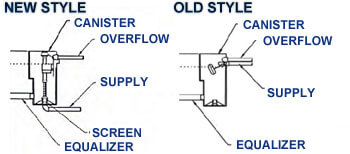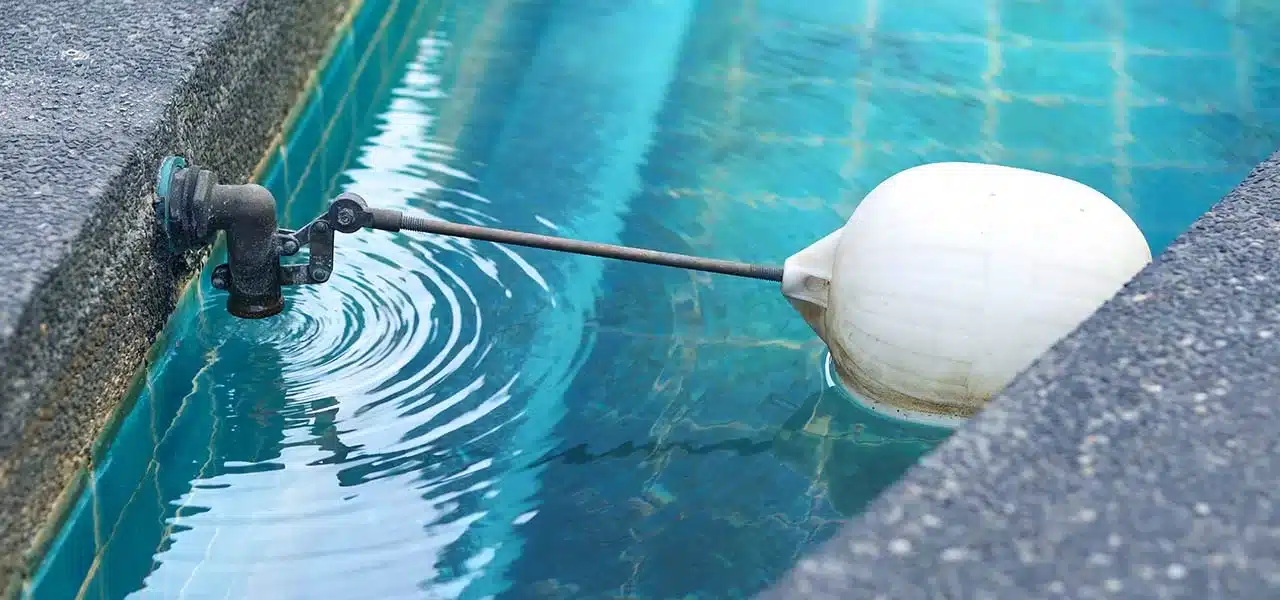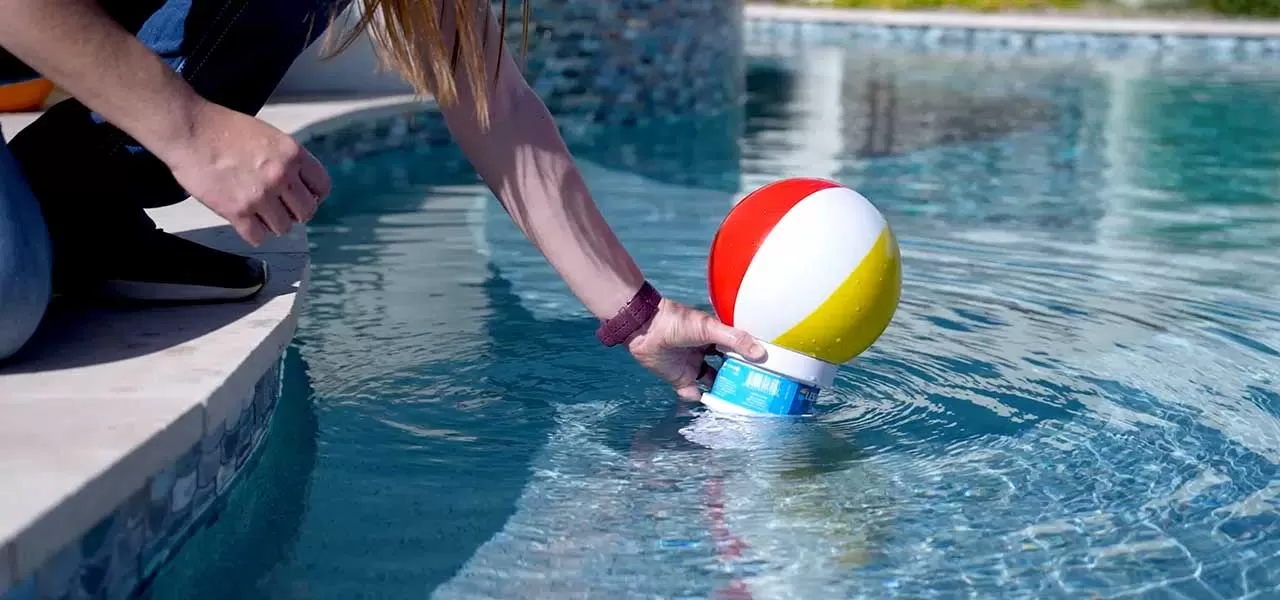The pool auto-fill is an automatic pool water leveler, designed to maintain the optimum water level in pools, spas, and fountains. They are more commonly employed in the warmer regions of the United States — in dry and arid regions that have to add water frequently.
Automatic pool fillers have been around for a long time and gained popularity in the 1970s with pools in the southern region. The first auto-fill devices were made by American Products and PoolMiser, and the poolside canister design has not changed all that much. That is, until recently, when Pentair introduced model T40F, with a familiar FluidMaster style of float valve, used in most common toilet tanks. The Brass valve and float model T40B, is also available from Pentair.
Old Style and New Style Auto-Fill Valves

The two auto-fill valve designs are technically not interchangeable, because the Brass Valve and Float connects to the incoming water supply near the top of the canister (or automatic filler bucket), and the vertically oriented FluidMaster Auto-Fill Valve, connects to the water supply at the bottom center of the canister (see image). Many Brass Valve canisters also have a bottom center port however, and in such cases, the new style valve can be installed if you also move the water supply line from the upper-side to the center-bottom of the canister.
Replacing the entire unit with the newer style is also possible, however the task can be arduous. Excavate around the cylinder carefully and gently cut the equalizer line and the water supply line. After breaking free the canister from the pool wall or its concrete encasement, the new canister is placed level with the pool, and pinned to the pool wall or otherwise secured to prevent movement or settling. After reconnecting the equalizer and water supply line, pressure test to confirm no leaks, before backfilling and tamping the area, or pouring new concrete. It may be simpler to fill it full of concrete, or otherwise and seal it off, and install a new wireless auto-fill in your pool filter area.
Leaking Pool Auto-Fill Valve
Leaks can occur in several places in a pool auto-fill, and cause loss of large amounts of water. If not winterized properly, the cylinder or bucket can crack. In some cases, this can be repaired with a good application of Pool Putty. If an auto-fill valve begins to malfunction, it can leak out through the overflow line or around the lid. Too much rain can also cause a cylinder to overflow, mimicking a leak.
The leaks of larger concern and consequence are those around the incoming water supply line and the outgoing pool equalizer line. Movement in the ground (or pool) can crack pipes or fittings, leading to underground leaks. Not winterizing an auto-fill could also cause cracks in the water supply line, and possibly also to the equalizer line.
In severe cases you may want to shut it off and abandon an auto-fill, at least temporarily. Shut off or disconnect the water supply, and plug the equalizer line on both ends, in the pool wall, and inside the canister. Use a #8x extended plug, or our W1084 plug, for standard 1.5″ equalizer lines.
For proper winter protection, pool auto-fills can be winterized. Plug the equalizer line on the pool side, and use a hand siphon pump to drain the cylinder. Shut off the valve to the water supply line and fully drain the supply pipe or blow out with air. Pour a quart of non-toxic pool antifreeze into the auto-fill cylinder, or fill a clean quart bottle 1/2 full of antifreeze and place inside the auto-fill chamber, to protect the cylinder from ice expansion. Or if the auto-fill canister is dry, place a 12″ square of heavy plastic between the lid and the frame, to block rain and snow melt.
Pool Auto-Fill Maintenance
There is not a lot to do to keep your pool auto-fill operating correctly – the main thing is to just check on it once in a while – to be sure that it is still operating, correctly.
Auto-fill floats may need occasional adjustments to maintain optimum water level. T26 Brass Valves have a small wing nut to allow for float adjustment, so you can set the float to a higher or lower maintained water level.
Newer FluidMaster style valves are adjustable by squeezing the clip to slide float higher or lower on the guide rod. They can also be further adjusted by turning the valve to raise or lower the height of the float.

Fluidmaster style valves may also need occasional cleaning of the shaft to keep the float sliding freely. Debris and scum can cause the float to get stuck – either always on, or always off. In addition, Fluidmaster valves have a screen located in the base that may fill up with sediment from time to time and reduce water flow by a noticeable amount. Or if the screen is not in place or has become damaged, small bits of debris can clog up the works. Flush out with water in reverse direction to clear internal valve blockages, or simply replace with a new T29 Auto-Fill Valve.
A New Generation of Auto-Fill Devices
A new breed of pool auto-fill devices have hit the market. A wireless sensor is affixed to the pool tile line, and when the sensor dries out, this signals a solenoid valve to open, and release water directly into the pool return line. With exception to water supply line, and the water sensor mounted in the tile or skimmer, all other equipment is located aboveground, at the pool equipment pad. Having everything visible removes some of the black box mystery, and also makes troubleshooting leaks or problems a bit easier.
Wireless pool auto-fill systems are available from Kona Labs and with the Jandy Levelor Water Leveler system.



Auto fill won’t turn off even if pool water is at the right level which is 1/3 pass skimmer opening. The water level in the autofill bucket will not fill enough to raise the float bottle.
I used the leak detector in the skimmer and did not find any leak.
Could the leak be at the canister of auto fill valve. The canister is black. If I lift the float, water turns off.
Hi Yolanda, many times the auto fill float just has some debris stuck in it, or needs some small adjustment, to operate correctly. If you can find the valve to shut off water to the autofill, then you can determine if there really is a leak (don’t forget evaporation can be over 1/4″ per day). The canisters can leak, and so can the pipe that brings water to the auto-fill.
We’re new to pools and we had to fill it with a hose after a few weeks of summer and thought that was odd. Found out what an auto fill is and found ours. Old horizontal ball valve. The hole between the auto fill and the pool was clogged with grassy weeds. I’ve yanked most of those out and can get a hanger rod through the hole into the pool. The water in the auto fill is totally murky and I want to prevent more weeds. Can I put chlorine or bleach or something in there?
Hi Karen, yes totally bleach it out! Dump 1/2 gallon of regular household unscented bleach in there, or dissolve some pool shock in a gallon of water and add.
HOW DOES THE AUTO FILL WORK WHEN THE OUTLET OF THE SUMP DOES NOT GO BACK TO THE POOL? IT USES A HOSE AND CHECK VALVE TO GO BACK INTO THE PUMP. IS IT SOME KIND OF SIPHON EFFECT?
Hi Caesar, it could be a siphon effect, using a venturi manifold or something